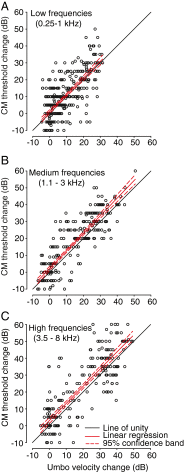Conductive hearing loss induced by experimental middle-ear effusion in a chinchilla model reveals impaired tympanic membrane-coupled ossicular chain movement
- PMID: 23615802
- PMCID: PMC3705087
- DOI: 10.1007/s10162-013-0388-x
Conductive hearing loss induced by experimental middle-ear effusion in a chinchilla model reveals impaired tympanic membrane-coupled ossicular chain movement
Erratum in
- J Assoc Res Otolaryngol. 2013 Aug;14(4):465. Tollin, Daniel [corrected to Tollin, Daniel J]
Abstract
Otitis media with effusion (OME) occurs when fluid collects in the middle-ear space behind the tympanic membrane (TM). As a result of this effusion, sounds can become attenuated by as much as 30-40 dB, causing a conductive hearing loss (CHL). However, the exact mechanical cause of the hearing loss remains unclear. Possible causes can include altered compliance of the TM, inefficient movement of the ossicular chain, decreased compliance of the oval window-stapes footplate complex, or altered input to the oval and round window due to conduction of sound energy through middle-ear fluid. Here, we studied the contribution of TM motion and umbo velocity to a CHL caused by middle-ear effusion. Using the chinchilla as an animal model, umbo velocity (V U) and cochlear microphonic (CM) responses were measured simultaneously using sinusoidal tone pip stimuli (125 Hz-12 kHz) before and after filling the middle ear with different volumes (0.5-2.0 mL) of silicone oil (viscosity, 3.5 Poise). Concurrent increases in CM thresholds and decreases in umbo velocity were noted after the middle ear was filled with 1.0 mL or more of fluid. Across animals, completely filling the middle ear with fluid caused 20-40-dB increases in CM thresholds and 15-35-dB attenuations in umbo velocity. Clinic-standard 226-Hz tympanometry was insensitive to fluid-associated changes in CM thresholds until virtually the entire middle-ear cavity had been filled (approximately >1.5 mL). The changes in umbo velocity, CM thresholds, and tympanometry due to experimentally induced OME suggest CHL arises primarily as a result of impaired TM mobility and TM-coupled umbo motion plus additional mechanisms within the middle ear.
Figures






Similar articles
-
The conductive hearing loss due to an experimentally induced middle ear effusion alters the interaural level and time difference cues to sound location.J Assoc Res Otolaryngol. 2012 Oct;13(5):641-54. doi: 10.1007/s10162-012-0335-2. Epub 2012 May 31. J Assoc Res Otolaryngol. 2012. PMID: 22648382 Free PMC article.
-
Effects of tympanic membrane perforation on middle ear transmission in gerbil.Hear Res. 2019 Mar 1;373:48-58. doi: 10.1016/j.heares.2018.12.005. Epub 2018 Dec 15. Hear Res. 2019. PMID: 30583199
-
Mechanisms of hearing loss resulting from middle-ear fluid.Hear Res. 2004 Sep;195(1-2):103-30. doi: 10.1016/j.heares.2004.05.010. Hear Res. 2004. PMID: 15350284
-
Analysis of middle ear mechanics and application to diseased and reconstructed ears.Am J Otol. 1997 Mar;18(2):139-54. Am J Otol. 1997. PMID: 9093668 Review.
-
Middle ear ossicles motion at hearing thresholds with air conduction and bone conduction stimulation.J Acoust Soc Am. 2006 May;119(5 Pt 1):2848-58. doi: 10.1121/1.2184225. J Acoust Soc Am. 2006. PMID: 16708943 Review.
Cited by
-
Temporary Unilateral Hearing Loss Impairs Spatial Auditory Information Processing in Neurons in the Central Auditory System.Front Neurosci. 2021 Nov 1;15:721922. doi: 10.3389/fnins.2021.721922. eCollection 2021. Front Neurosci. 2021. PMID: 34790088 Free PMC article.
-
Intractable middle ear effusion in EGPA patients might cause permanent hearing loss: a case-control study.Allergy Asthma Clin Immunol. 2022 Aug 6;18(1):68. doi: 10.1186/s13223-022-00706-x. Allergy Asthma Clin Immunol. 2022. PMID: 35933390 Free PMC article.
-
Intracochlear Pressures in Simulated Otitis Media With Effusion: A Temporal Bone Study.Otol Neurotol. 2018 Aug;39(7):e585-e592. doi: 10.1097/MAO.0000000000001869. Otol Neurotol. 2018. PMID: 29912830 Free PMC article.
-
Audiometric Outcomes of Ventilation Drainage Treatment for Otitis Media with Effusion in Children: Implications for Speech Development and Hearing Loss.Med Sci Monit. 2023 Sep 27;29:e941350. doi: 10.12659/MSM.941350. Med Sci Monit. 2023. PMID: 37752698 Free PMC article.
-
The chinchilla animal model for hearing science and noise-induced hearing loss.J Acoust Soc Am. 2019 Nov;146(5):3710. doi: 10.1121/1.5132950. J Acoust Soc Am. 2019. PMID: 31795699 Free PMC article. Review.
References
-
- Bennett MJ, Weatherby LA. Newborn acoustic reflexes to noise and pure-tone signals. J Speech Hear Res. 1982;25:383–387. - PubMed
-
- Bluestone CD, Klein JO (eds) (1995) Definitions, terminology, and classification. In: Otitis media in infants and children, 2nd edn. W.B. Saunders Co., Philadelphia p 1–3
-
- Browning GC, Granich M. Surgical anatomy of the temporal bone in the chinchilla. Ann Otol Rhinol Laryngol. 1978;87:875–882. - PubMed
Publication types
MeSH terms
Substances
Grants and funding
LinkOut - more resources
Full Text Sources
Other Literature Sources
Research Materials
Miscellaneous

